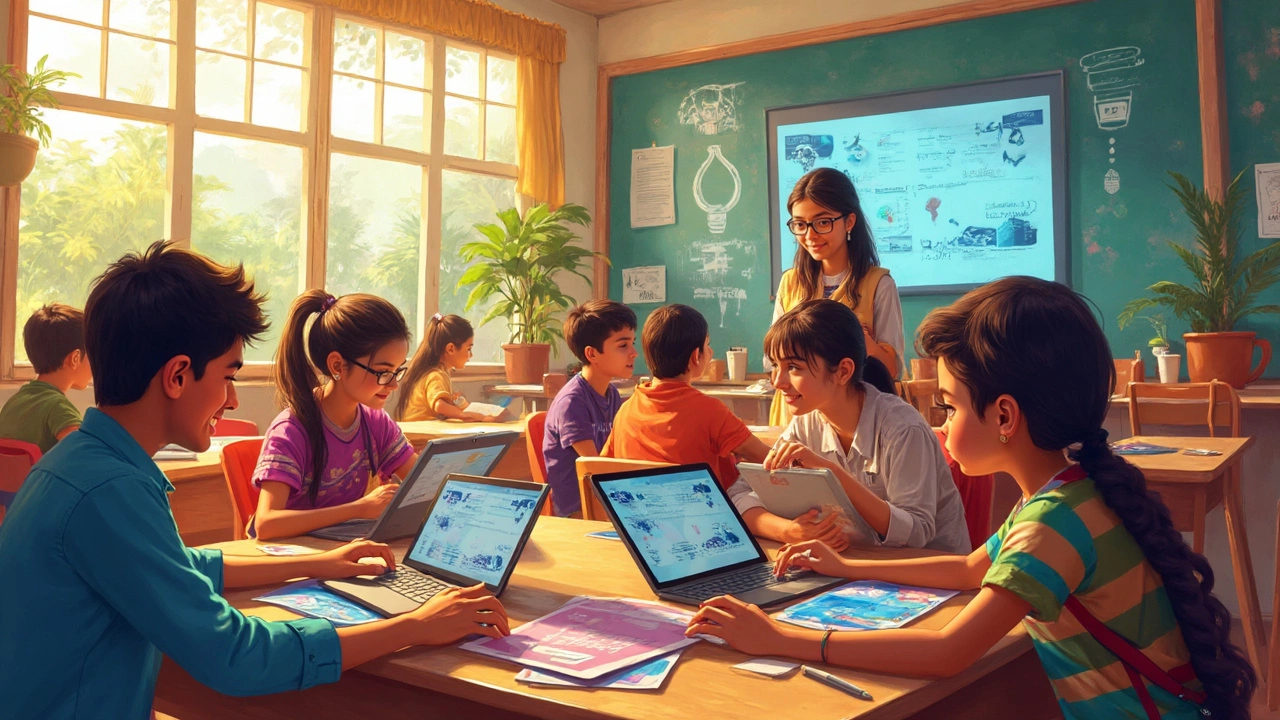eLearning, or electronic learning, has a ton of names that often get tossed around like confetti. Whether you're a student logging in for an online course or a teacher setting up a digital classroom, it's good to know what all these terms mean. Is 'online learning' the same as 'distance education'? Does 'virtual learning' cover more than just video calls? Don't worry; we'll break it down.
So, why the many names? Well, each one points to different features. Online learning highlights the internet as the main delivery method. Distance education often involves older models like correspondence courses or newer ones like MOOCs (Massive Open Online Courses). Virtual learning, on the other hand, might focus on simulations or virtual classrooms. Knowing these can help you pick what suits your needs best.
- Understanding eLearning
- Different Names and Their Meanings
- Evolution of Digital Learning
- Tips for Choosing the Right Platform
- Future Trends in eLearning
Understanding eLearning
If you've been around the education space recently, you've probably heard the term eLearning a lot. But what exactly is it? Simply put, eLearning is a learning system that we deliver using electronic resources. Now, if you think about it, this is quite broad. It means any kind of education that gets scoped and delivered entirely online.
Components of eLearning
Here's where it gets interesting. eLearning isn't just about video calls or online forums. It's an entire ecosystem that includes:
- Interactive content like quizzes and simulations to make learning engaging.
- Learning management systems (LMS) where learners can access resources, submit assignments, and get feedback.
- Multimedia elements like videos and podcasts to cater to different learning styles.
A good thing about eLearning is the flexibility. You get to pick up courses anytime, anywhere. It's perfect when you want to balance learning with work, family, or other commitments.
The Rise of eLearning Platforms
According to a 2023 study, the global eLearning market was predicted to hit nearly $375 billion by 2026! No surprise here, considering the spike in demand for accessible education. Platforms like Coursera, Udemy, and Khan Academy are leading the charge, making it super easy for learners to access a variety of courses.
These platforms also offer a range of courses, from digital education for coding enthusiasts to personal development courses for just about anyone looking to expand their skill set.
Challenges and Considerations
Of course, it's not all rosy. One big challenge for online learning is the lack of face-to-face interaction. Sometimes, this can make it tough to stay motivated. To overcome this, it's helpful to set a study schedule and seek active participation in forums and discussion groups.
Another consideration is the quality of courses. Not all eLearning is created equal, so it’s crucial to research reviews and course previews before diving in.
Different Names and Their Meanings
When people talk about eLearning, they're often pointing to different styles and technologies that make learning possible outside a traditional classroom. These names can tell you a lot about what kind of experience to expect.
Online Learning
This is the broad umbrella for any learning facilitated over the internet. If you're attending a class through a web browser, that's online learning. It's super flexible, allowing learners to access content anytime, anywhere. This approach became a lifeline during the COVID-19 pandemic, when schools had to switch to remote options.
Virtual Learning
Virtual learning usually means there's some sort of real-time interaction happening. Think of it as a digital version of your regular classroom. Teachers and students can chat live via Zoom, Microsoft Teams, or other video conferencing tools.
Distance Education
Distance education isn't new. It started with correspondence courses where materials were mailed out. Today, it's evolved. Platforms like Coursera or edX offer full degrees online, letting you study at prestigious universities from your living room. It's perfect for those who need flexibility due to work or family commitments.
Blended Learning
Blended learning mixes face-to-face instruction with online activities. Imagine having part of your class in a lecture hall, and the rest on Moodle or Blackboard. This hybrid setup gives students a more rounded educational experience and has been shown to improve outcomes.
MOOCs (Massive Open Online Courses)
MOOCs are online courses available to anyone interested, often for free. They allow thousands of people worldwide to take the same class simultaneously. Though they don't always offer credits or degrees, platforms like Khan Academy or Coursera provide courses in everything from data science to poetry.
| Type of Learning | Main Feature | Flexibility |
|---|---|---|
| Online Learning | Internet-based | High |
| Virtual Learning | Real-time interaction | Medium to High |
| Distance Education | Remote university courses | Very High |
| Blended Learning | Combines offline and online | Variable |
| MOOCs | Massive participation | Flexible, Self-paced |
Knowing these terms keeps you informed, whether you’re skimming course catalogs or trying to explain to your family why you're now taking virtual salsa lessons. It's all about finding what suits your learning style, time, and budget the best.

Evolution of Digital Learning
From snail mail correspondence courses to interactive video lectures, the journey of eLearning has been quite the rollercoaster. Believe it or not, the first inklings of distance education date back to the 18th century when lessons were mailed out to eager learners. Fast forward, and the late 20th century saw computers and the internet change everything.
The Birth of Online Learning
The 1990s were a game-changer. The World Wide Web (remember when it was called that?) made online courses possible. Suddenly, you didn’t have to be in the same place as your teacher. Universities started offering distance education and online degrees became legit.
The Rise of Platforms
In the 2000s, platforms like Moodle and Blackboard came around. These weren’t just about reading materials online but about creating whole virtual classrooms. That's when digital education really took off, with new tools for video conferencing and interactive quizzes.
The COVID-19 Impact
During the COVID-19 pandemic, we saw a massive shift. Schools and businesses scrambled to adapt, and suddenly every home was a classroom. Platforms had to level up, fast. Not just for education, but also for arts, fitness, and every other imaginable purpose. It expanded the definition of what online learning could be.
Stats on Growth
| Year | Global eLearning Market Size (USD billion) |
|---|---|
| 2019 | 187 |
| 2020 | 250 |
| 2023 | 375 |
Experiencing such explosive growth, the industry shows no signs of slowing down.
Tips for Choosing the Right Platform
Picking the right eLearning platform can feel like looking for a needle in a haystack, but it doesn’t have to be. There are some key things to keep in mind that will make this process a whole lot easier.
Understand Your Learning Style
Do you thrive in a structured environment with scheduled virtual classes, or do you prefer to learn at your own pace? A platform like Coursera offers courses with deadlines, while others like Udemy allow you to go at your own speed.
Check the Content Variety
Some platforms excel in specific subjects. For example, MasterClass is great for creative fields, whereas LinkedIn Learning might better suit business-oriented skills. Make sure the eLearning platform has a good range of courses in areas you’re interested in.
Look at User Reviews
Reviews from other learners are goldmines of information. They provide insights into course quality, instructor interaction, and platform reliability. Sites like Trustpilot often have detailed reviews of online learning platforms.
Evaluate Tech Requirements
Ensure your device and internet connection can handle the platform’s requirements. Some digital education platforms require heavy video streaming, which might not work well on older devices or slower connections.
Consider the Cost
Price is always a key factor. Many platforms offer free trials or free courses. Compare prices and see if subscription models, like Skillshare’s, offer better value for the skills you want to learn.
Trial the Platform
Most platforms offer free trials. Use this time to explore its functionality and see if it matches your learning preferences.
| Platform | Specialization | Trial Period |
|---|---|---|
| Coursera | Various Academic Subjects | 7-Day Free Trial |
| Udemy | General Skill Development | Occasional Discounts |
| LinkedIn Learning | Professional Development | 1-Month Free Trial |
By keeping these tips in mind, you can make an informed decision and find a platform that’s just the right fit for you.

Future Trends in eLearning
eLearning is not just here to stay; it's charging into the future like a high-speed train. As technology evolves, it shapes how we learn and teach online. Let's peek into some of the trends that are set to make waves in the coming years.
1. Personalized Learning Experiences
Online platforms are getting smarter! They’re using AI to create personalized learning paths tailored just for you. Imagine having a virtual tutor who knows exactly what you struggle with and adapts the lessons to suit your style. This way, digital education becomes as unique as your fingerprint.
2. Gamification
Who said learning can't be fun? More eLearning platforms are integrating game elements. Think rewards for completing courses or leaderboards to beat. Gamification is set to keep learners engaged and motivated. And let’s face it, we all love a bit of competition!
3. Virtual and Augmented Reality
Strap on those VR headsets because VR and AR are taking online learning to another dimension—literally. Whether it's a virtual tour of ancient Rome or a hands-on physics experiment, these technologies make learning immersive and interactive.
4. Microlearning
Busy lives need quick learning solutions. Enter microlearning, where lessons are broken into bite-sized, digestible chunks. Perfect for when you're on the go but still want to pick up new skills without a huge time commitment.
5. Increased Focus on Soft Skills
Hard skills get you the job, but soft skills help you keep it. Expect to see a rise in courses focusing on communication, leadership, and other soft skills crucial in today's job market.
Interesting Fact: Growth of eLearning Market
What's fueling these trends is the growth of the eLearning market. By 2027, it's expected to hit nearly $375 billion. Here’s a snapshot of its growth trajectory:
| Year | Market Value (in billion USD) |
|---|---|
| 2021 | 250 |
| 2023 | 315 |
| 2025 | 345 |
| 2027 | 375 |
The key takeaway? If you're in the realm of eLearning, keep an eye on these trends—they're shaping the future!
